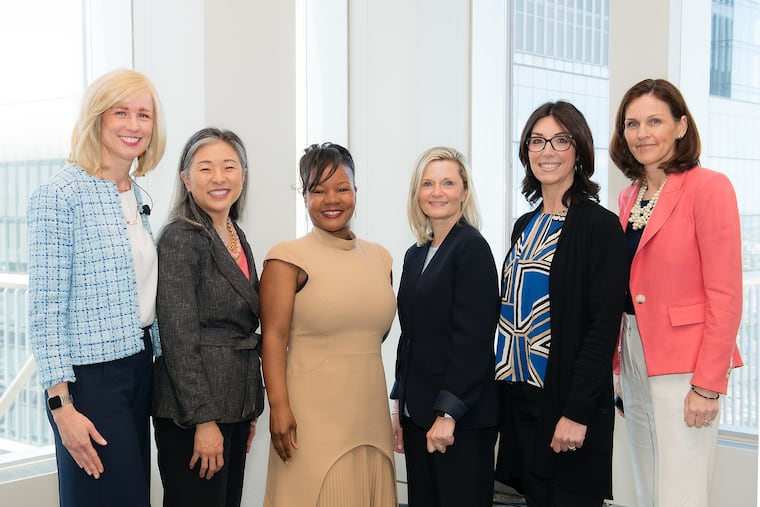Hybrid work is here to stay. These Philly business leaders say ‘we should stop complaining.’
While some have argued that in-office work will continue to increase post-pandemic, the majority of companies in Philadelphia are allowing employees to work remotely at least part-time.

Angela Wurster, vice president of the primary-care network at Children’s Hospital of Philadelphia (CHOP), noted that many of the people within her organization — and at any health-care provider — must be present in-person every day. With that constant reminder, she has an appreciation for the flexibility she enjoys by having to be in-office only three days a week.
“Hybrid is the best thing ever, and we talk about it like it’s a problem,” Wurster said. “We should stop complaining about it and celebrate it and acknowledge it and build it up.”
While some have argued that in-office work will continue to increase post-pandemic, the majority of companies in Philadelphia are allowing employees to work remotely at least part-time. The number of businesses that require fully in-person work has actually been declining in recent months, the Wall Street Journal reported this week.
» READ MORE: More Philly office workers will come back in-person on multiple days, downtown boosters predict
Wurster and four other Philadelphia-area executives gathered Wednesday to discuss career success in a hybrid or remote work environment at a panel hosted by executive coaching firm the Leader’s Edge. If their conversation is any indication, learning how to thrive in a flexible, partially virtual work environment will be useful for the foreseeable future.
Here are some of the tips they offered.
Stay visible
Wurster, of CHOP, works on the seventh floor, and most of the senior executives work 13 floors above. She regularly does what she calls a “drive by” on the 20th floor, popping into offices to say hello.
“Make sure you’re visible to people, and do it at all levels,” Wurster said. While this practice wasn’t feasible during the worst of the pandemic, it’s something she has resumed both in the office and at the CHOP primary-care locations she oversees.
Informally checking in with bosses is made easier with some amount of in-office work, and it helps fortify those relationships, panelists said. They also emphasized the importance of staying top-of-mind in one’s broader network, a task made easier by increased comfort with online professional networking.
“Follow up pragmatically on LinkedIn. Be willing to connect where there’s an opportunity,” said Aileen K. Alexander, CEO of Diversified Search Group.
Michelle Hong, coleader of Northern Trust Wealth Management’s Philadelphia office, encouraged sharing progress on the professional social-networking site and reflecting on lessons learned.
“If you are authentic and open about what your goal is and what you want to do better ... bring your network along in that journey,” said Hong.
Use meetings wisely
Tracey Santilli, president of communications firm Tierney, said her agency’s workforce is hybrid, generally spending three days a week in the office. On in-office days, leadership has been emphasizing educational experiences and interaction between staff, even if they’re not directly focused on client work, she said.
“We create these moments ... where people can build camaraderie in a much more organic way,” Santilli said. “We’re kind of using the office as the new off-site,” meaning that in-office days are more like company retreats.
While Zoom fatigue is real, virtual meetings can be meaningful, suggested Renita Miller, chief diversity, equity and inclusion officer at University of Pennsylvania’s Wharton School. She recalled being invited to a 15-minute, Friday morning virtual meeting when she started at Wharton, “and I thought to myself, this meeting is not going to be 15 minutes.”
But what impressed Miller, she said, is that the meeting was 15 minutes. It had a set agenda, focused on highlights of the week without delving into details, and acknowledged what the team had accomplished.
The short, virtual meeting she had originally met with skepticism ended up being “the most high-energy 15 minutes that I’ve ever experienced,” Miller said.
Chat more; let lines blur
Miller said she’s noticed across industries and organizations that people are placing more emphasis on finding meaning in their work, but that doesn’t require being serious all the time.
“Embrace small talk,” Miller said. “It just brings out the authenticity in a person to just have those small chitchat conversations. And they tend to blossom into so much more.”
Hong noted that in a traditional work environment, nonverbal body language and tone of voice carry much of a speaker’s meaning, while the actual words being said may make up 10% or less of the message. She said remote work has made her “more curious” as a leader.
“When we’re in a remote world or in a hybrid world, there’s more reliance on that 10% and you lose, a lot of times, the rest of it,” Hong said. “You don’t have as much opportunity to understand what your team needs or what your clients need.”
What people used to understand or learn implicitly must now be spelled out explicitly, Hong said, and leaders should be sure to ask people clearly what they need to reach their goals.
That’s not to say overcommunication is reserved for cyberspace. All five panelists emphasized the importance of connecting with coworkers, clients, and networking contacts on a human level online and in-person.
“Work is not separate from life,” Santilli said. “We blurred the lines.”